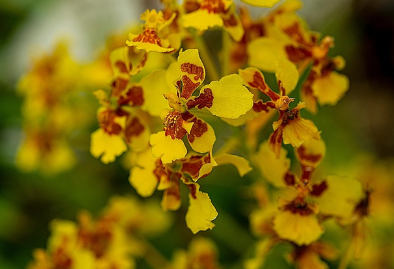
Aloha!
Like flowers that bloom in unexpected places, every story unfolds with beauty and resilience, revealing hidden wonders.
Please see below for specific care instructions based on the plant you need help with!
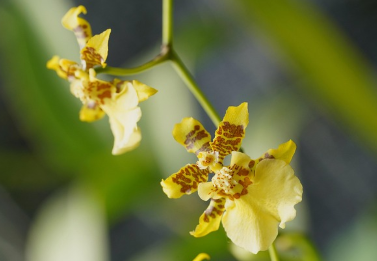
Oncidium
🌟 Oncidium Orchid Care Guide 🌟
Light 🌞
Oncidium orchids thrive in bright, indirect light. A spot near an east or west-facing window is ideal! 🌸 They can tolerate some morning sunlight, but be careful with intense midday sun—it can scorch their leaves.
Temperature 🌡️
- Daytime: 75–85°F (24–29°C)
- Nighttime: 60–65°F (15–18°C)
These orchids enjoy day-night temperature variation, so keep it cooler at night to help with blooming! ✨
Watering 💧
Water thoroughly once the top inch of the potting medium feels dry. 🏞️ Oncidiums like their roots to dry out between waterings, so don’t let them sit in water.
- During active growth: Water every 5–7 days.
- During dormancy: Water less frequently—every 10-14 days.
Humidity 💕
Oncidiums appreciate moderate humidity (around 50-60%). If the air in your home is dry, consider placing your orchid on a humidity tray or using a small humidifier nearby. 🌱
Fertilizing 🌼
- During growth: Feed with a balanced orchid fertilizer (like 30-10-10) every 2-3 weeks.
- During dormancy: Cut back on feeding, as the orchid is resting. 🌿
Potting & Repotting 🪴
Repot every 1-2 years or when the roots outgrow the pot. 🏵️ Be gentle with their roots—Oncidiums don’t mind being a little root-bound!
Rest Period 💤
Allow your Oncidium to rest after flowering, giving it cooler temperatures, less water, and no fertilizer. 🌸 This helps them recharge for their next round of blooms.
Pests & Diseases 🦠
Be vigilant for pests like mealybugs, aphids, and spider mites. Ensure good air circulation and don’t overwater to keep the orchid healthy and free from rot. 🌿
Flowering 🌷
Oncidiums are known for their beautiful, fragrant flowers—often resembling dancing ladies! 🌼 They bloom in late winter or spring, and the flowers can last for weeks. To encourage flowering, try giving them a cooler resting period.
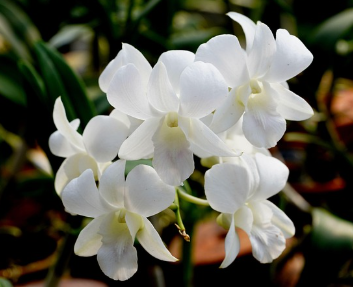
Dendrobium
🌸 Dendrobium Orchid Care Guide 🌸
Light 🌞
Dendrobium orchids love bright, indirect light. A sunny windowsill with a sheer curtain or near an east or west-facing window is perfect! 🌿 Too much direct sunlight can cause leaf burn, so give them a bit of shade during the hottest parts of the day.
Temperature 🌡️
- Day: 75–85°F (24–29°C)
- Night: 60–65°F (15–18°C)
These orchids thrive with a slight temperature drop at night. Too much heat can stress them out, so try to maintain a comfortable environment for your little beauty! 🌙
Watering 💧
Water thoroughly when the top inch of the potting mix feels dry. Dendrobiums are sensitive to overwatering, so ensure good drainage. 🏞️
- During growth: Water once a week.
- During dormancy (winter): Water less frequently—around every 10–14 days.
Humidity 💕
They love humidity! Aim for 50-60%. If your home is dry, consider a humidity tray or a small humidifier. 🌱
Fertilizing 🌼
- During growth: Feed with a balanced orchid fertilizer (e.g., 30-10-10) every 2-3 weeks.
- During dormancy: Cut back on fertilizing. 🌾
Potting & Repotting 🪴
Repot every 1-2 years, preferably after blooming or when new growth appears. 🌻
Rest Period 💤
Some Dendrobiums need a rest after blooming. During this time, give them cooler temps, less water, and no fertilizer to encourage a new cycle of growth and blooms. 🌸
Pests & Diseases 🦠
Keep an eye out for pests like mealybugs or aphids. Ensure good air circulation and avoid keeping your orchid too wet to prevent rot. 🌿
Flowering 🌷
Many Dendrobiums bloom in the winter to spring, typically from old canes. Some varieties need a cool rest period to kickstart their beautiful flowers. 🌟
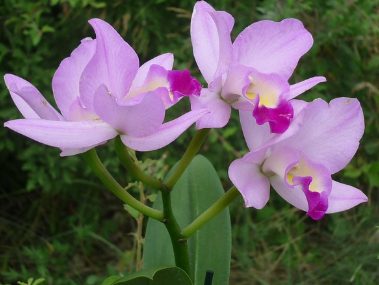
Cattleya
🌼 Cattleya Orchid Care Guide 🌼
Light 🌞
Cattleyas need bright, indirect light to thrive. A south or east-facing window is ideal for them. They can even tolerate a bit of direct morning sunlight, but be careful—too much can burn their leaves! 🌿
Temperature 🌡️
- Daytime: 75–85°F (24–29°C)
- Nighttime: 60–65°F (15–18°C)
Cattleyas love warm temperatures during the day and a slight drop at night. They bloom best when there’s a noticeable day-night temperature variation! 🌙
Watering 💧
Water thoroughly when the potting mix feels dry about 1 inch deep. 🏞️ Avoid letting your Cattleya sit in water, as they don’t like soggy roots!
- During growing season: Water every 7–10 days.
- During dormancy: Water less frequently—every 10-14 days or when the mix feels dry.
Humidity 💕
Cattleyas love moderate humidity (50-60%). If your home is dry, try placing your orchid on a humidity tray or using a small humidifier to keep the air around it slightly moist. 🌱
Fertilizing 🌼
- During growth: Feed with a balanced orchid fertilizer (like 30-10-10) every 2–3 weeks to support blooming.
- During dormancy: Reduce feeding during the rest period.
Potting & Repotting 🪴
Repot every 1-2 years or when the roots start outgrowing the pot. 🌻 Be gentle with their roots while repotting!
Rest Period 💤
After blooming, your Cattleya will benefit from a rest period. During this time, water less, and cut back on feeding. Keeping them in slightly cooler conditions (around 55-60°F) can help trigger future blooms. 🌸
Pests & Diseases 🦠
Keep an eye out for pests like mealybugs or aphids. Ensure good air circulation to avoid fungal and bacterial infections. And remember, never let the roots sit in water to prevent rot. 🌿
Flowering 🌷
Cattleyas are famous for their showy, fragrant flowers! 🌺 They typically bloom once or twice a year, and their flowers can last for weeks. To encourage blooms, make sure your orchid gets plenty of light, and give it a cooler rest period after blooming.
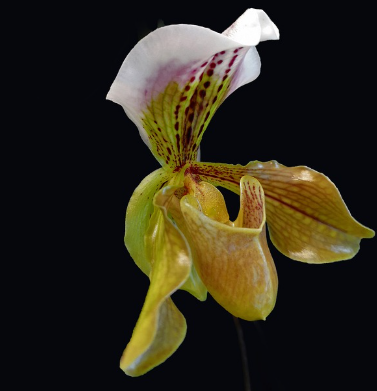
Paphiopedilum
🌸 Paphiopedilum Orchid Care Guide 🌸
Light 🌞
Paphiopedilum orchids (also known as lady slippers) prefer low to moderate, indirect light. They’re not fans of bright, direct sunlight! A north or east-facing window is perfect for them, or a spot with filtered sunlight. 🌿
Temperature 🌡️
- Daytime: 70–80°F (21–27°C)
- Nighttime: 55–65°F (13–18°C)
These orchids love cooler nights and warm days. Keep them in a space where the temperature drops a little at night to encourage healthy growth. 🌙
Watering 💧
Water Paphiopedilum orchids thoroughly, but let the top inch of the potting medium dry out before watering again. They like it moist but not soggy! 🏞️
- During growing season: Water every 5–7 days.
- During rest period: Water less often, around every 10 days.
Humidity 💕
Paphiopedilums love humidity—aim for around 50-60%. If the air is dry, consider a humidity tray or a humidifier near your orchid. 🌱 They thrive in slightly more humid environments!
Fertilizing 🌼
- During active growth: Fertilize with a balanced orchid fertilizer (like 30-10-10) every 2–3 weeks.
- During rest period: Stop fertilizing to give your orchid a chance to rest and recharge. 🌾
Potting & Repotting 🪴
Repot every 1–2 years or when the plant outgrows its pot. Be gentle with their roots as they don’t like disturbance! 🌻
Rest Period 💤
Paphiopedilums typically don’t need a hard rest period, but after blooming, reduce watering and stop fertilizing for about a month to give them a chance to recuperate. 🌸
Pests & Diseases 🦠
Watch out for common pests like mealybugs, aphids, or spider mites. Ensure good air circulation and avoid overwatering to prevent root rot. 🌿
Flowering 🌷
Paphiopedilum orchids are known for their unique, beautiful lady slipper-shaped flowers! 🌺 They bloom once a year or more, and flowers can last for several weeks. To encourage flowering, make sure the orchid gets the right balance of light, humidity, and cool nights.
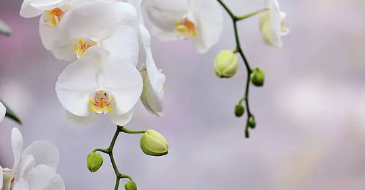
Phalaenopsis
🌺 Phalaenopsis Orchid Care Guide 🌺
Light 🌞
Phalaenopsis orchids (also known as moth orchids) love bright, indirect light! A south or east-facing window works best, but avoid direct sunlight—it can burn their leaves! 🌿 If the leaves turn yellow, it might mean they need more light.
Temperature 🌡️
- Daytime: 70–85°F (21–29°C)
- Nighttime: 60–70°F (15–21°C)
Phalaenopsis orchids enjoy a comfortable temperature range, with a slight drop at night to promote blooming. Keep them in a cozy, well-lit spot! 🌙
Watering 💧
Water once a week or when the top inch of the potting mix feels dry. Be sure to drain excess water—Phalaenopsis orchids don’t like sitting in water! 🏞️
- In winter: Water a little less often since they’re not actively growing.
Humidity 💕
Phalaenopsis orchids prefer higher humidity (around 50–70%). If the air in your home is dry, try using a humidity tray or a humidifier nearby to keep the air around your orchid moist. 🌱
Fertilizing 🌼
- During growing season: Feed with a balanced orchid fertilizer every 2 weeks.
- During rest period (winter): Reduce fertilizing and water less often.
Potting & Repotting 🪴
Repot Phalaenopsis orchids every 1-2 years, or when the roots outgrow their pot. They prefer a well-draining potting mix, like orchid bark or sphagnum moss. 🌻 Be sure to repot after blooming to avoid disturbing any new growth.
Rest Period 💤
Phalaenopsis orchids don’t need a strict rest period, but they will naturally slow down in winter. During this time, reduce watering and stop fertilizing to let them rest. 🌸
Pests & Diseases 🦠
Watch out for pests like mealybugs, aphids, and scale. Also, keep an eye out for root rot caused by overwatering. Make sure your orchid has good air circulation and avoid letting it sit in water for too long. 🌿
Flowering 🌷
Phalaenopsis orchids are famous for their beautiful, long-lasting blooms. 🌺 They can flower multiple times a year, and their flowers often last for 2-3 months! After blooming, you can trim the flower spike to encourage new blooms or leave it for a while to see if it will bloom again. 🌟
Zygopetalum
🌸 Zygopetalum Orchid Care Guide 🌸
Caring for your gorgeous Zygo!
🌿 Light: Bright, but not too bright!
- Zygos love bright, indirect light. A little morning sun or filtered light is perfect.
- Avoid direct sunlight, as it can burn their leaves.
- If the leaves start turning yellow or brown, they may be getting too much sun!
💧 Watering: Keep it just right!
- Water when the top 1-2 inches of soil feel dry. Don’t overwater!
- They like their roots to dry out a little between waterings.
- Tip: Water early in the day to prevent water sitting on the leaves overnight, which can cause rot.
🌡️ Temperature: They like it comfy!
- Keep them in temperatures between 65–75°F (18–24°C) during the day.
- Nights can be a bit cooler—around 55–60°F (13–16°C).
- Avoid placing near drafts or air conditioners.
🧴 Humidity: Let’s get moist!
- Zygo orchids love humidity—aim for around 50-70% humidity.
- Use a humidity tray, or mist the leaves occasionally to keep the air moist.
- Be sure not to let water collect in the crown of the plant to avoid rot!
🌱 Potting: Give those roots room to grow!
- Repot every 1-2 years to refresh the potting medium and give those roots room to breathe.
💡 Fertilizing: Feed them gently!
- Fertilize with a balanced orchid fertilizer (like 30-10-10) every 2 weeks during the growing season (spring and summer).
- Cut back to once a month during the dormant season (fall and winter).
- Tip: Dilute the fertilizer to half-strength to avoid overfeeding.
🌸 Blooming: Enjoy the beauty!
Keep an eye out for their sweet fragrance as the blooms open!
Zygos bloom once or twice a year, with flowers that can last for weeks.
To encourage blooms, give your Zygo a cooler period of 2-4 weeks in fall with reduced watering. This signals to the plant to start producing flowers!
Grammatophyllum
🌿 Grammatophyllum Orchid Care Guide 🌿
Caring for Your Majestic Grammatophyllum Orchid!
🌞 Light: Bright and bold!
- Grammatophyllum orchids love bright, indirect light.
- They can tolerate some direct sunlight in the morning or late afternoon, but too much direct sun can burn their leaves.
- Tip: If the leaves turn yellow or brown, they might be getting too much sun.
💧 Watering: Keep it moist, not soggy!
- Water when the top 1-2 inches of soil feel dry.
- Don’t let the plant sit in water. Ensure your pot has good drainage.
- Tip: During winter, water a little less since the plant slows down. In the growing season (spring and summer), water more frequently.
🌡️ Temperature: Warm and cozy!
- Keep your Grammatophyllum orchid in temperatures between 65–85°F (18–29°C).
- It prefers warm weather, but it can tolerate brief dips down to 55°F (13°C) at night.
- Tip: Keep away from cold drafts or areas with fluctuating temperatures.
💨 Humidity: Let’s keep it tropical!
- These orchids thrive in high humidity, around 50–70%.
- Use a humidifier, a humidity tray, or occasionally mist the leaves to keep the air moist.
- Tip: Don’t let water sit on the leaves for too long as it can cause rot.
🌱 Potting: Root room is important!
- Use a well-draining orchid mix with bark, perlite, and sphagnum moss.
Tip: Repot your orchid every 1-2 years to refresh the potting medium and prevent overcrowded roots.
🧴 Fertilizing: Feed them gently!
- Feed with a balanced orchid fertilizer (like 20-20-20) once a month during the growing season.
- In the fall and winter months, reduce feeding to once every 6 weeks.
- Tip: Always dilute the fertilizer to half strength to avoid overfeeding.
🌸 Blooming: Watch for the stunning flowers!
Tip: To encourage blooming, give the plant a cooler period (around 60°F or 15°C) in the winter. This will help trigger the flower spike!
Grammatophyllum orchids can bloom once a year, typically in the spring or summer.
Their flowers are large, showy, and often spotted, resembling a tiger’s pattern!
Grammatophyllum
🌿 Cymbidium Orchid Care Guide 🌿
Caring for Your Elegant Cymbidium Orchid!
🌞 Light: Bright with a touch of shade!
Cymbidiums love bright, indirect light — even more than many other orchids.
They can handle a bit more direct sun, especially in cooler climates, but protect them from harsh midday rays.
Tip: Pale or yellow leaves may indicate too much sun; dark green leaves may mean too little.
💧 Watering: Hydration with care!
Water thoroughly when the top inch of medium feels dry. Let excess water drain freely.
Never let it sit in soggy conditions — that leads to root rot.
Tip: During active growth (spring and summer), water more often. In fall and winter, reduce watering.
🌡️ Temperature: Cool nights, warm days!
Cymbidiums thrive with a temperature drop at night. Ideal range:
Day: 65–75°F (18–24°C)
Night: 50–60°F (10–15°C)
Tip: The cooler nights help trigger flower spikes — a must for blooming!
💨 Humidity: A bit of a boost helps!
They prefer moderate humidity, around 40–60%.
In dry indoor air, use a humidity tray or mist occasionally (but not heavily).
Tip: Good airflow is important — avoid stuffy, stagnant conditions.
🌱 Potting: Keep it airy!
Use a coarse, well-draining orchid mix with bark and perlite. Cymbidiums also like a slightly heavier mix to support their larger pseudobulbs.
Tip: Repot every 2–3 years after blooming, when new growth appears.
🧴 Fertilizing: A little love goes a long way!
Feed with a balanced orchid fertilizer (like 20-20-20) every 2–3 weeks during growing season.
Switch to a low-nitrogen formula in late summer to promote blooming.
Tip: Always water first, then fertilize — never on dry roots.
🌸 Blooming: Showstoppers in the cool season!
Cymbidiums bloom in late fall to early spring, with tall spikes of waxy, long-lasting flowers in stunning colors.
Tip: To initiate blooms, provide a 10–15°F (5–8°C) temperature drop at night starting in late summer.